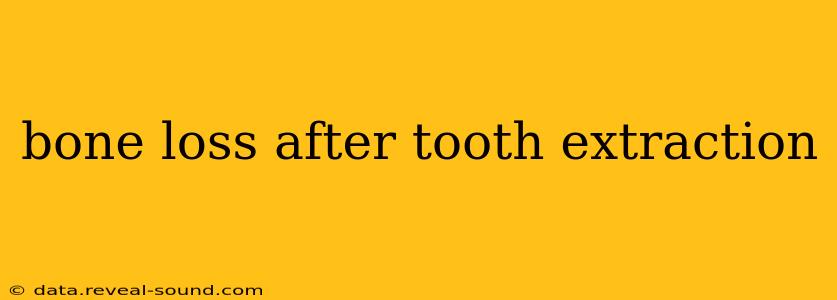Losing a tooth is never easy, but understanding the potential for bone loss afterward can help manage expectations and proactively protect your jawbone health. This comprehensive guide explores the causes, effects, and prevention of bone loss following tooth extraction.
What is Alveolar Bone Loss After Tooth Extraction?
Alveolar bone is the specific type of bone that surrounds and supports your teeth. After a tooth is extracted, the alveolar bone that once supported that tooth begins to resorb, or break down, due to the lack of stimulation from the tooth's root. This bone loss is a natural process, but its extent can vary depending on several factors. Understanding this process is crucial for maintaining jawbone health and preventing further complications.
How Much Bone Loss is Normal After Tooth Extraction?
The amount of bone loss varies significantly from person to person and depends on factors like the individual's overall health, the type of extraction (simple or surgical), and the time elapsed since the extraction. While some degree of bone loss is expected, excessive bone loss can lead to problems with adjacent teeth, difficulty with future implant placement, and changes in facial structure.
What Causes Bone Loss After Tooth Extraction?
Several factors contribute to bone resorption after a tooth extraction:
- Lack of stimulation: The most significant cause is the absence of the tooth root, which previously stimulated bone growth and maintenance.
- Infection: Post-extraction infections can accelerate bone loss.
- Smoking: Smoking significantly impairs healing and increases the risk of bone loss.
- Poor oral hygiene: Inadequate oral hygiene can lead to infection and impede healing.
- Underlying medical conditions: Certain medical conditions, such as diabetes, can affect bone healing.
How Long Does It Take for Bone Loss to Occur After Tooth Extraction?
Bone loss typically begins soon after extraction but occurs gradually over time. The most significant loss usually happens within the first six months, although resorption can continue at a slower rate for years.
How Can I Prevent Bone Loss After Tooth Extraction?
Preventing excessive bone loss involves proactive measures both before and after the extraction:
- Maintain excellent oral hygiene: Brush and floss regularly, and use an antimicrobial mouthwash as directed by your dentist.
- Follow post-extraction instructions carefully: Adhere to your dentist's recommendations for healing and follow-up appointments.
- Consider bone grafting: Bone grafting is a surgical procedure that involves replacing lost bone tissue. It's often recommended before dental implant placement.
- Get regular dental checkups: Regular visits help detect and address any problems early.
- Quit smoking: Smoking significantly hinders healing and increases the risk of complications.
- Maintain a healthy diet: A balanced diet rich in calcium and vitamin D supports bone health.
Does Bone Loss After Tooth Extraction Affect Other Teeth?
Yes, significant bone loss can affect the stability of adjacent teeth. The loss of supporting bone can lead to shifting and tilting of nearby teeth. This can cause further problems, including misalignment and increased risk of periodontal disease.
Can I Get Dental Implants After Bone Loss?
Yes, but the success of dental implants depends on the amount of remaining bone. In cases of significant bone loss, bone grafting or other augmentation procedures may be necessary before implant placement. Your dentist or oral surgeon will assess the bone volume and recommend the most appropriate treatment plan.
What are the Treatments for Bone Loss After Tooth Extraction?
Several treatments can address bone loss, including:
- Bone Grafting: This involves surgically placing bone material (autograft, allograft, or synthetic) into the extraction site to stimulate bone regeneration.
- Guided Bone Regeneration (GBR): This technique uses a membrane to protect the bone graft and guide bone growth.
- Socket Preservation: This involves filling the extraction socket immediately after tooth removal with a bone graft or other material to prevent excessive bone loss.
This information is for general knowledge and does not constitute medical advice. Always consult with your dentist or oral surgeon for personalized recommendations regarding your specific situation. Early intervention is key to minimizing bone loss and preserving your jawbone health.
